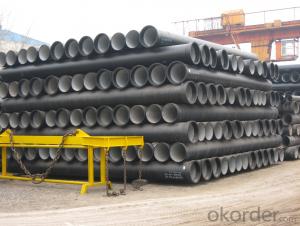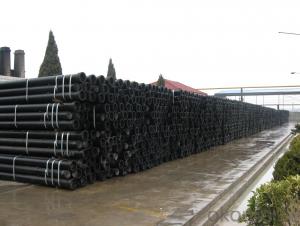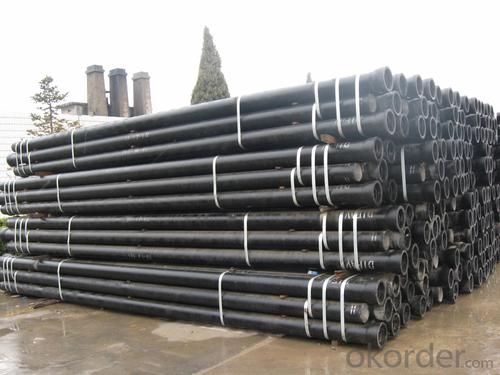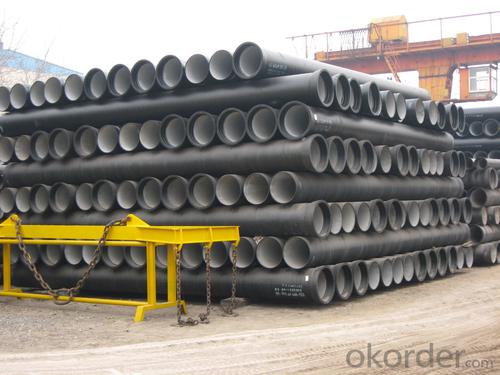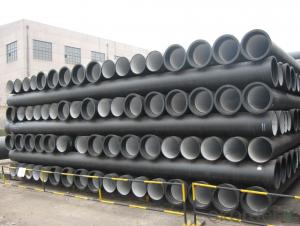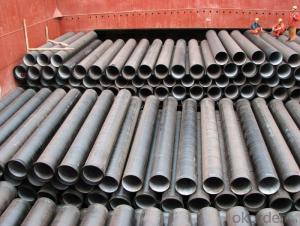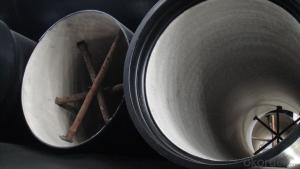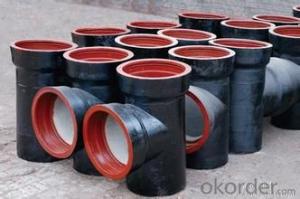DUCTILE IRON PIPE DN100 K9
- Loading Port:
- China Main Port
- Payment Terms:
- TT or LC
- Min Order Qty:
- 21 m.t.
- Supply Capability:
- -
OKorder Service Pledge
OKorder Financial Service
You Might Also Like
Specification:
1) The standard of pipe: ISO2531:1998, K9
2) Effective length: 6m
3) Inner cement line: Portland cement line as per ISO4179
4) Zinc coating: at least 130g/m2 as per ISO8179
5) Bitumen painting: at least 70um as per ISO8179
6) With 100% quantity of NBR ring, or SBR ring, or EPDM ring as per ISO4633
7) DN80mm-800mm
8) High strength, lighter than grey iron, good corrosion resistance, no furring, small flow resistance, easy fixing, long life tome about 100 yeas
9) Produced by Hangzhou chunfeng machine
10) Checked by automatic inspection equipment
11) Composition:
Chemical composition | ||||||
Chemical composition | Ductile Cast Iron Pipe (%) | Grey iron pipe (%) | Steel pipe (%) | |||
C | 3.5-4.0 | 3.2-3.8 | 0.1-0.2 | |||
Si | 1.9-2.6 | 1.4-2.2 | 0.15-0.4 | |||
Mn | 0.15-0.45 | 0.4-0.6 | 0.3-0.6 | |||
P | ≤0.06 | ≤0.3 | 0.02-0.03 | |||
S | ≤0.02 | ≤0.1 | 0.02-0.03 | |||
Mg | 0.03-0.06 | |||||
12) Feature:
Mechanical properties | ||||||
Ductile Cast Iron Pipe | Grey Iron Pipe | Steel Pipe | ||||
Tensile Strength(Mpa) | ≥420 | 150-260 | ≥400 | |||
Yield Strength(Mpa) | ≥300 | No Confirmation | No Confirmation | |||
Bending Strength(Mpa) | ≥590 | 200-360 | ≥400 | |||
Elongation (%) | ≥10 | Neglected | ≥18 | |||
Brinell Hardness(HBS) | ≤230 | ≤230 | About 140 | |||
13) T type mechanical joint
14) Packing: in bulk or container
Specifications
1.20 years manufacturing and exporting experiences.
2.ISO2531,BSEN545 standard.
3.DN80-DN1800,Centrifugal casting,K9
- Q: Can ductile iron be welded? Is weldability comparable to gray iron?
- The tensile strength of more than or equal to 70000 PSI (more than 482 n / mm2) yield strength: General 62000 (more than 427 n / mm2)Hardness (HB): 185HBWith the parent material color: similar power options: AC and DC dual-use, DC DC reverse connection
- Q: Can ductile iron pipes be used in potable water systems?
- Yes, ductile iron pipes can be used in potable water systems. Ductile iron is a suitable material for water distribution systems as it has excellent durability, strength, and corrosion resistance. It is commonly used in potable water systems due to its ability to withstand high water pressure and its long service life. Additionally, ductile iron pipes are also approved by various national and international standards for use in potable water applications.
- Q: Ductile cast iron can replace copper sleeve
- Under dry friction conditions, we design a pre - formed synovial membrane on the surface of the bearing to ensure that the solid lubricant is transferred to the dual parts in the shortest possible time, and an effective solid lubricant film is formed
- Q: What new technologies are there for the installation of ductile iron pipes?
- Because the new flexible interface mechanism of cast iron drainage pipe pipe in the development of China's relatively short history, compared with other drainage pipes, people know little of the present, with some experience of the author in the construction, the application of the performance, characteristics and engineering, to do some simple introduction.
- Q: What is the composition of ductile iron pipes?
- Ductile iron pipes consist mainly of iron, with small amounts of carbon, silicon, and other alloying elements. The iron content typically ranges from 90% to 94%, while carbon content is usually around 3% to 4%. Silicon is added between 1.5% to 3%, which enhances the ductility and strength of the iron. Smaller quantities of manganese, sulfur, and phosphorus may also be present. The composition of ductile iron pipes is carefully engineered to achieve specific properties. By adding carbon and silicon, the hardness and strength of the iron are improved, making it suitable for demanding applications. These alloying elements also contribute to the pipes' ductility, allowing them to be easily bent and molded without breaking. In summary, the composition of ductile iron pipes is designed to strike a balance between strength, ductility, and resistance to corrosion. This makes them ideal for use in water and sewage systems, where they can endure high pressure, bear heavy loads, and resist the corrosive effects of water and other chemicals.
- Q: How do ductile iron pipes handle cyclic loading in offshore applications?
- Ductile iron pipes are known for their exceptional strength and durability, making them a suitable choice for various applications, including offshore use. When it comes to handling cyclic loading in offshore environments, ductile iron pipes have several characteristics that contribute to their performance. Firstly, ductile iron pipes have a high resistance to fatigue failure. Fatigue failure occurs when a material experiences repeated cycles of stress, which can cause cracks to initiate and propagate over time. Ductile iron pipes are designed to withstand cyclic loading without compromising their structural integrity, thanks to their inherent ductility and ability to absorb and distribute stress effectively. Additionally, ductile iron pipes possess excellent impact resistance. Offshore environments are prone to dynamic and unpredictable forces, such as waves and currents, which can exert sudden and high impact loads on the pipes. The high impact resistance of ductile iron allows it to withstand these forces without deformation or fracture, ensuring the pipes remain intact and functional. Moreover, ductile iron pipes have a unique microstructure that enables them to resist corrosion. Offshore applications expose pipes to harsh environmental conditions, including saltwater, which can accelerate the corrosion process. However, the protective graphite matrix in ductile iron pipes acts as a barrier, preventing corrosive agents from reaching the underlying metal and significantly extending the pipes' service life. Furthermore, ductile iron pipes have a high load-carrying capacity. In offshore applications, pipes often need to support heavy loads, such as those from equipment, structures, or seabed settlements. Ductile iron's superior strength allows it to bear these loads effectively, maintaining the structural integrity and stability of the system. Lastly, ductile iron pipes offer ease of installation and maintenance. Their lightweight nature makes them easier to handle and transport during offshore operations. Additionally, their corrosion resistance minimizes the need for frequent maintenance, reducing downtime and costs associated with repairs and replacements. In conclusion, ductile iron pipes exhibit excellent performance in handling cyclic loading in offshore applications. Their resistance to fatigue failure, impact resistance, corrosion resistance, high load-carrying capacity, and ease of installation and maintenance make them a reliable and efficient choice for offshore environments.
- Q: Are ductile iron pipes resistant to corrosion?
- Yes, ductile iron pipes are resistant to corrosion. Ductile iron is a type of cast iron that has been treated with additional materials to make it more flexible and durable. These materials, such as graphite, magnesium, and cerium, create a protective barrier on the surface of the pipe, making it highly resistant to corrosion. Additionally, ductile iron pipes are often coated with a layer of cement mortar or a fusion-bonded epoxy coating, further enhancing their resistance to corrosion. This makes ductile iron pipes suitable for use in various applications, including water distribution, wastewater treatment, and industrial pipelines, where corrosion is a common concern.
- Q: Are ductile iron pipes resistant to biological growth?
- Yes, ductile iron pipes are generally resistant to biological growth. Ductile iron is a strong and durable material that is commonly used in water and sewage systems. Its smooth surface inhibits the growth of bacteria, fungi, and other microorganisms that can contribute to biological growth. Additionally, ductile iron pipes are often coated with protective linings or coatings, such as cement mortar or epoxy, which further enhance their resistance to biological growth. However, it is important to note that no material is completely immune to biological growth, and regular maintenance and cleaning of the pipes may still be required to ensure long-term resistance.
- Q: Can centrifugal cast iron pipe be galvanized or coated with asphalt which is good for corrosion prevention?
- 1, outdoor grounding of anti-corrosion, we must consider the contact resistance, so it is recommended not to use asphalt, and do not use anti-corrosion paint, preferably galvanized anti-corrosion.2, asphalt anti-corrosion paint has good water resistance, moisture resistance, corrosion resistance. Acid and alkali resistance, salt fog resistance, atmospheric exposure and so on. The utility model is suitable for coating internal and external surfaces of various containers and machinery, underground steel structures and underground pipelines for moisture proof, water resistance and corrosion prevention. The utility model is also suitable for repairing water cracks in houses.3, anticorrosive paint is used in the surface of the object, can be used to protect the interior of the object without corrosion of a kind of paint. It is one of the more commonly used than paint anti-corrosion paint in industrial construction, widely used in aviation, shipbuilding, chemical, oil pipelines, steel structures, bridges, oil rigs and other fields, by the vast number of manufacturers favor building.
- Q: Can ductile iron pipe be used in high-pressure applications?
- Yes, ductile iron pipe can be used in high-pressure applications. Ductile iron pipe is known for its strength and durability, making it suitable for a variety of applications, including high-pressure systems. It has a higher tensile strength and yield strength compared to other types of cast iron pipes, allowing it to withstand higher pressures. Additionally, ductile iron pipe is resistant to corrosion and can maintain its structural integrity even under high-pressure conditions. However, it is important to ensure that the pipe is properly installed, and all necessary safety measures are followed to ensure the safe and efficient operation of the high-pressure system.
Send your message to us
DUCTILE IRON PIPE DN100 K9
- Loading Port:
- China Main Port
- Payment Terms:
- TT or LC
- Min Order Qty:
- 21 m.t.
- Supply Capability:
- -
OKorder Service Pledge
OKorder Financial Service
Similar products
Hot products
Hot Searches
Related keywords


